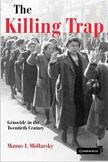
To many people, including Nobel Peace Prize-winning author and Holocaust survivor Elie Wiesel, it seems illogical to apply logic to a human behavior as heinous as genocide. But that is the goal of political scientist Manus Midlarsky in his book, “The Killing Trap: Genocide in the Twentieth Century.”
“Elie Wiesel has taken the position that this [the Holocaust] is an event of such magnitude and enormity that … it can’t be understood,” said Midlarsky, the Moses and Annuta Back Professor of International Peace and Conflict Resolution in New Brunswick. “These events were perpetrated by human beings and we’ve got to figure out why. We also must find out why in some instances genocide did not occur.”
The search for the genesis of genocide provides much of the basis for “The Killing Trap,” published last year by Cambridge University Press. Midlarsky distinguishes among genocides, genocidal behavior, politicides, ethnic cleansings and massacres based, in part, upon the state’s motives and ultimate goals, targeted population(s), and duration and intensity of the killing.
He defines genocide as the state-sponsored systematic mass murder of innocent men, women, and children denoted by a particular ethnoreligious identity. Its purpose: to eradicate that group from a given territory. Vulnerability of the targeted group and a real or purported connection with threats to state security are necessary conditions for genocide to occur. Validation – the absence of consequences for perpetrators – is a third condition. In the 20th century, genocides and related behaviors took more than an estimated 40 million lives.
Midlarsky emphasizes the socioeconomic and international contexts surrounding genocides of European Jews, Armenians in the Ottoman Empire, and the Tutsis in Rwanda, which he compares and contrasts with the deadly plights of black Africans in Darfur, Cambodians, Bosnians, and the victims of conflict in Northern Ireland. He draws parallels among the Jews, Armenians and Tutsis, the three genocides upon which he concentrates. “The proximate causes were war-related,” he said.
For example, Germany’s defeat in World War I, with its attendant territorial losses and near-crippling economic hardships, which many erroneously and maliciously blamed on the Jews, remained in the collective memory of Germans as World War II began in 1939. Still, Midlarsky posits that genocide of the Jews didn’t become a reality for Hitler until the German invasion of the Soviet Union in June 1941 was halted and the pending entry of America into the war promised a protracted and almost certainly fatal two-front conflict.
While Midlarsky started writing “The Killing Trap” about four years ago, the seeds were planted almost a half-century earlier when as a teenager in 1954, he visited an uncle living in an Israeli transit camp, awaiting resettlement within the Jewish state. The uncle had fled eastern Poland with his immediate family for a Russian city during World War II, and those he left behind were murdered.
During a Yom Kippur memorial service for the dead, Midlarsky heard such anguished weeping that “it was as if the many dead in the full extent of their suffering had entered the consciousness of the living. “Such intensity of feeling was too much for a 17-year-old relatively sheltered American,” Midlarsky recalled.
He repressed the memory for 30 years, allowing it to resurface only when his wife, Elizabeth, a professor at Columbia University’s Teachers College, asked him to contribute an article to a journal in the midst of a research project on the rescue of Jews during the Holocaust. His article received a favorable citation in a review article on altruism in another professional journal and led Midlarsky to subsequent research on ethnic conflict and eventually genocide.
Read more about "The Killing Trap: Genocide in the Twentieth Century” at Cambridge.